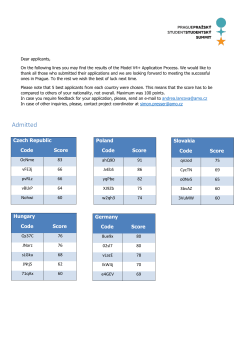
Document
Sea-level fluctuations show Ocean Circulation controls Atlantic Multidecadal Variability GERARD D. MCCARTHY IVAN D. HAIGH JOEL J.-M. HIRSCHI JEREMY P. GRIST DAVID A. SMEED AMO and Ocean Circulation • The Atlantic is a place of large multi-decadal variability esp. the Atlantic Multi-decadal Oscillation of SSTs (AMO) • The AMO has a range of important climate impacts (left: from Zhang and Delworth, 2007, GRL) • It is widely hypothesised that the AMOC controls the phases of the AMO through control of ocean heat content e.g. Delworth and Mann, 2000, Clim. Dyn. • … but there are no direct observational records of sufficient length to prove this Observations to prove a link • We use the excellent and long-running tide gauge record along the east coast of the US to develop a proxy for ocean circulation to show the AMOCAMO link • Sea-level is an integrated measure of the water column that can be used to infer circulation First attempts date back to Montgomery in 1938! McCarthy et al., under review in Nature, Ocean control of decadal Atlantic climate variability revealed by sea-level observations Dynamic sea-level gradient • We use a different approach from previous attempts, which focused on a coastal tide gauge and an offshore sea level measurement Mean dynamic sea-level • We focus on the gradient along the coast, which reduces the impact of eddies on circulation estimates (a la Kanzow et al., 2009) • This responds to AMOC declines e.g. Yin et al., Nat. Geoscience, 2009 Response to reduced AMOC Sea-level dataset • This coastline is subject to Glacial Isostatic adjustment and land subsidence effects • To study dynamic sea level we remove a linear trend and de-seasonalise • The tide gauges are highly meridionally coherent, breaking into two groups north and south of Cape Hatteras Level (m) (arbitrarily offset) Sea Level Anomalies Site No. 3 30 2.5 25 2 20 1.5 15 1 10 0.5 5 0 1900 1920 1940 1960 Year 1980 2000 Sea-level dataset • This coastline is subject to Glacial Isostatic adjustment and land subsidence effects • To study dynamic sea level we remove a linear trend and de-seasonalise Site no. • The tide gauges are highly meridionally coherent, breaking into two groups north and south of Cape Hatteras Corr. 1 30 29 28 27 26 25 24 23 22 21 20 19 18 17 16 15 14 13 12 11 10 9 8 7 6 5 4 3 2 1 0.95 0.9 0.85 0.8 0.75 0.7 0.65 0.6 0.55 0.5 0.45 0.4 0.35 0.3 0.25 0.2 0.15 0.1 0.05 1 2 3 4 5 6 7 8 9 10 11 12 13 14 15 16 17 18 19 20 21 22 23 24 25 26 27 28 29 30 Site no. A sea-level index of circulation • The sea-level index projects onto the circulation in the intergyre region, which has links to both overturning and gyre but most importantly heat transport into subpolar gyre • The AMO is a subpolar focused phenomenon so heat transport into it is the crucial factor mean dynamic topo contours SST anomalies >0.5ºC during warm AMO phase (hatched) Bermuda-based index • Ezer suggested the difference of sea level from Bermuda to Atlantic city as an AMOC proxy • However, Sturges and Hong (1995) had shown decadal sea level oscillations at Bermuda could be reproduced using a Rossby wave model Bermuda Relationship to NAO • The NAO forces this circulation • The NAO leads the sea-level index by a year and is significantly correlated (r=0.71 at the 98% level, 1950-2012; r=0.61 at the 98% level, 1920-2012) Relating to heat content changes • • • • Our sea-level index estimates circulation Circulation is proportional to heat transport e.g. Johns et al, 2011, J. Clim. Therefore accumulation of the sea-level index estimates heat content In fact, as a measure of transport in the intergyre region, it leads subpolar heat content by 2 years Relationship to AMO • The 7-year sea-level index leads the 7-year rate of change of the AMO by 2 years and is significantly correlated (r=0.51, significant at the 96% level) • Therefore the index offers predictability of the AMO NAO, sea-level index and AMO • Extending back to the 1920’s, the relationship between the accumulated NAO, accumulated sea-level index and AMO holds On forcing: AMO and Ocean Circulation • Using the meridional gradient of dynamic sea level along the US east coast, we provide the first observational evidence that ocean circulation drive the phases of the AMO • The NAO forces the circulation changes, which the ocean integrates as heat content and returns as the AMO • Periods of accelerated sea-level rise along the US east coast (Sallenger et al. and others) should be listed as a climate impact of the AMO • The sea level offers a predictability to the AMO: it indicates that we are transitioning to a negative AMO at present McCarthy et al., under review in Nature, Ocean control of decadal Atlantic climate variability revealed by sea-level observations
© Copyright 2025









